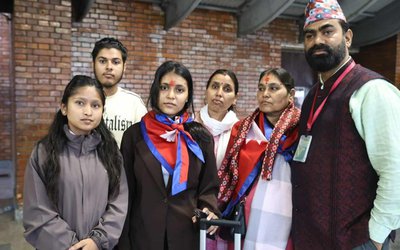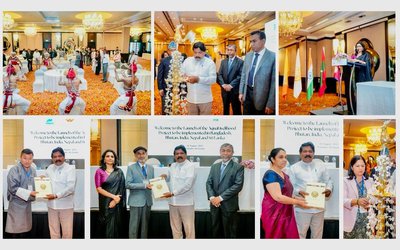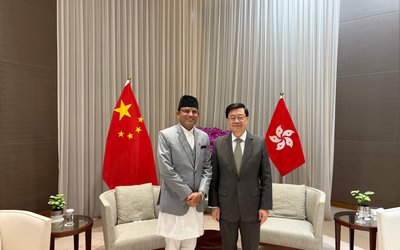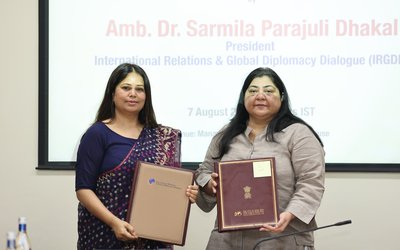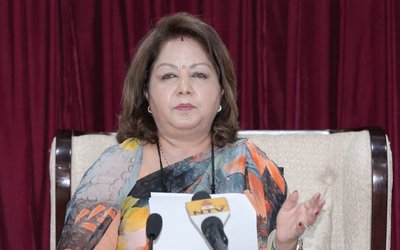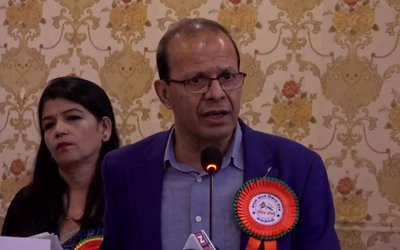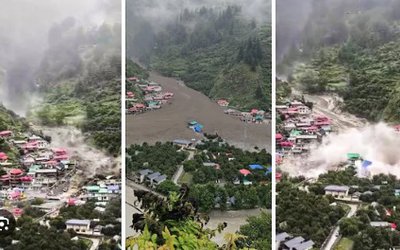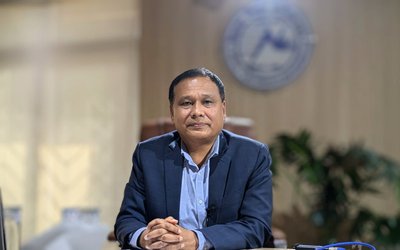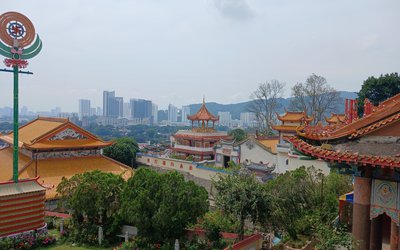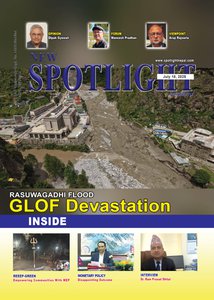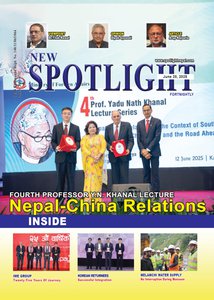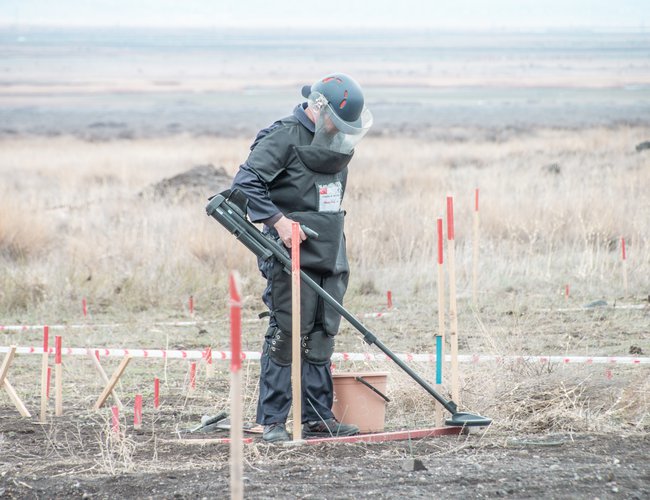
Landmines threaten peace, recovery, and lives
Landmine hazards are one of the most insidious legacies of conflict as explosive devices often lie lurking undetected beneath the surface of the land for decades only to be one day triggered by pressure, proximity, or tripwires. These hidden killers continue to exact a devastating toll: in 2023 alone, 5,757 casualties were reported across 55 countries, a 22% rise from the previous year. Civilians comprised 84% of the total victims and children accounted for over one-third of those civilians (Landmine Monitor, 2023). Beyond the tragic human cost, landmines cripple post-conflict recovery by rendering vast swathes of land unusable for farming, resettlement, and infrastructure, particularly in vulnerable and rural communities. With 58 countries and territories still contaminated, landmines are not merely the remnants of past wars, they are active barriers to peace, development, and human security and therefore demand urgent and sustained international action.
Landmine hazards are a grave and persistent threat worldwide, particularly in regions scarred by prolonged conflict such as Sub-Saharan Africa, the Middle East, South and Southeast Asia, the Pacific, and Eastern Europe (Landmine Monitor, 2023). Countries like Cambodia, Lao PDR, Vietnam, and Myanmar in Southeast Asia; Afghanistan, Pakistan, Sri Lanka, and India in South Asia; the Solomon Islands, Papua New Guinea, Palau, the Marshall Islands, and Micronesia in the Pacific; Haiti and Cuba in the Caribbean; and Angola, Sudan, DR Congo, Egypt, Libya, and Somalia in Africa bear the brunt of global contamination. High-risk nations such as Afghanistan, Yemen, Syria, Ukraine, and Myanmar epitomize the devastating human cost; in some areas of these nations, civilians, especially children, constantly face the possibility of injury or death. Beyond the immediate toll in lives, landmines isolate communities, block access to farmland, water sources, and roads, and paralyze efforts toward recovery, resettlement, and sustainable development. These silent killers not only perpetuate human suffering but also act as long-term barriers to peace, economic progress, and resilience.
The most recent global approach to landmine risk reduction emphasizes integrating climate-smart strategies that recognize the impacts of climate change, such as floods, landslides, and erosion, which can expose or displace landmines to new areas, complicating clearance efforts. This approach focuses on adapting mine action operations to address shifting environmental challenges, ensuring that clearance methods are flexible and responsive to changing landscapes. In addition, innovative technologies like drones, AI, and robotics are being increasingly utilized to enhance the efficiency and safety of demining operations, particularly in regions with extensive contamination. At the same time, the approach highlights the importance of community-driven efforts that ensure mine action plans are gender-sensitive and inclusive, especially for marginalized populations such as indigenous communities, thereby fostering sustainable and equitable post-conflict recovery.
The triple burden of landmines: Lives, livelihoods, and ecosystems
Sokha (name changed), a farmer from rural Cambodia, never imagined that yet another ordinary day in his fields would change his life forever. While working on his family’s land, the source of his livelihood, he was struck by a landmine explosion. Tragically, he lost both his parents in that blast and was left with permanent disabilities that meant he was unable to continue farming, his family’s only means of income. To pay for medical treatment, Sokha’s family had to sell its plot of land and productive livestock, deepening its financial crisis. Living in a remote area with limited access to resources, the already struggling family had to assume the burden of caring for Sokha. His injury deprived his children of the opportunity to attend school; indeed, they were forced to perform child labor just to make ends meet. Sokha’s wife, overwhelmed by the emotional and financial strain, fell into a deep depression. This heartbreaking story paints a vivid picture of how a single landmine risk doesn’t devastate just an individual but instead spirals into a profound cycle of poverty, stifling hope and opportunities for an entire family, trapping it in the inescapable consequences of a senseless tragedy. This case reveals that landmine risks create a complex challenge, with civilians suffering both physical harm and psychological trauma. The loss of farmland, displacement, disrupted humanitarian aid, environmental damage, and financial strain on national economies all compound the difficulties associated with an individual’s loss, trapping communities in a cycle of poverty and delaying long-term recovery.
Civilian casualties and psychological trauma: Landmine hazards inflict devastating and long-lasting impacts on civilians. They cause thousands of injuries and deaths each year, with children often being among the most affected of all. In Afghanistan, one of the world’s most heavily mined countries, more than 120,000 people have been killed or injured by landmines and unexploded ordnance (UXO) since 1988 (UNMAS, 2023). Survivors frequently endure permanent disabilities and deep psychological trauma, such as PTSD, anxiety, and depression, all conditions which severely limit their ability to reintegrate into society, find employment, and support their families. This cascading effect fuels economic instability, especially in already vulnerable communities, where lost productivity and restricted mobility disrupt agriculture, trade, and access to essential services. As a result, entire regions are left struggling in the aftermath of a landmine explosion, trapped in prolonged cycles of trauma, poverty, and insecurity which make landmine risks not just a humanitarian crisis but a chronic obstacle to development.
Loss of agricultural land and livelihoods: Landmine contamination has devastated agricultural livelihoods in countries such as Cambodia, where an estimated 1,640 square kilometers of land remains unsafe for use (CMAC, 2023). Hidden explosives have rendered fertile farmland inaccessible, depriving rural communities of their primary sources of food, income, and resilience. As families are unable to cultivate crops or raise livestock, food insecurity deepens, malnutrition rises, and poverty becomes entrenched. The economic fallout ripples through entire regions, stalling local markets, disrupting generations of farming tradition, and increasing dependence on humanitarian aid. Over time, the social fabric of these communities frays as rising displacement and migration weakens cohesion and stability. The persistent presence of landmines not only cripples livelihoods but also obstructs long-term development and recovery. Agricultural rehabilitation then becomes a critical pillar of post-conflict reconstruction.
Displacement and inhibited resettlement: Landmine contamination has become a major driver of displacement and inhibited resettlement, particularly in countries such as Colombia, where over 12,000 people have fallen victim to landmines since 1990 (ICBL, 2023). Rural and Indigenous communities are often forced to flee their ancestral lands during conflicts, and, even after peace accords, many cannot return due to the ongoing threat of explosive remnants. This prolonged displacement pushes families into overcrowded and under-resourced urban slums or informal settlements, where access to basic services such as healthcare, education, and even clean water is severely limited. The rupture of community networks and cultural ties undermines social cohesion and increases vulnerability to exploitation, violence, and psychological trauma. Economically, the inability to reclaim or resettle on safe land halts local recovery, perpetuating cycles of poverty, dependence on aid, and long-term instability. Landmines not only uproot lives but systematically erode the social and economic foundations necessary for sustainable peace and reintegration.
Obstruction of humanitarian aid and development: Landmine contamination is a formidable barrier to humanitarian aid and development, particularly in conflict-affected regions such as Yemen, where explosives have been planted along key supply routes and farmland. According to the Norwegian Refugee Council (2023), these hidden threats are a primary reason why over 13 million Yemenis are out of the reach of life-saving assistance. The presence of landmines delays and even blocks the delivery of critical supplies such as food, medicine, and shelter and severely restricts emergency medical evacuations and infrastructure repair. This obstruction cripples not only immediate relief but also long-term recovery and development as communities are unable to rebuild essential services, restart livelihoods, or resume education. Ultimately, the unaddressed presence of landmines traps entire populations in a protracted crisis, deepening poverty, prolonging displacement, and undermining regional stability and resilience.
Environmental and ecosystem degradation: Landmine contamination inflicts a profound and often overlooked toll on the environment, particularly in biodiversity-rich and climate-vulnerable regions. In places such as Bosnia and Herzegovina, forest ecosystems have suffered decades of disruption, with unnatural vegetation growth and fragmented wildlife corridors among the consequences of inaccessible, mine-laden terrain. The process of demining itself often involves disturbing soil and clearing vegetation and thus stresses fragile ecosystems. As climate change intensifies, hazards will escalate: floods, landslides, and droughts will increasingly dislodge buried mines, potentially reinstating threats in previously mapped areas and complicating clearance efforts, as has been observed in Afghanistan, South Sudan, and elsewhere. These environmental shifts not only endanger civilians and responders but also degrade natural resources, jeopardizing access to clean water, arable land, and forest products that are essential for survival. According to UNEP, UNMAS, and the World Bank (2023), such degradation directly undermines food security, local livelihoods, and disaster preparedness. Despite the growing urgency, climate-smart and environmentally integrated mine action remains grossly underfunded, revealing a critical blind spot in both humanitarian and development planning. Without targeted investment in ecosystem-sensitive demining, communities will remain locked in a vicious cycle of environmental decline, economic marginalization, and prolonged recovery.
Economic costs and the burden on national budgets: Landmine contamination imposes a staggering economic cost and a heavy, long-term burden on national budgets, especially in countries emerging from conflict. In Angola, for example, over $250 million will be required to meet demining targets by 2028, a cost draining public resources that could otherwise fund vital sectors such as education, healthcare, and infrastructure. The financial strain extends far beyond clearance operations; it also extends to the lifelong medical care, rehabilitation, and social support survivors need. For low-income countries, these opportunity costs are devastating; they compound existing vulnerabilities and delay pathways to recovery and inclusive growth. When government spending has to be rerouted toward addressing landmine hazards, economic diversification, job creation, and poverty reduction efforts are all sidelined. This redirection of funding not only hampers national development but also entrenches cycles of dependency and underdevelopment, reinforcing socio-economic fragility in already precarious regions.
Catalysts for change: UN agencies, donors, and policy reforms
The 1997 Ottawa (Mine Ban) Treaty is the foundation of global mine action. It unites 164 signatories in banning the use, production, stockpiling, and transfer of anti-personnel landmines. Countries such as Mozambique have demonstrated its transformative impact, with Mozambique declared mine-free in 2015 after clearing over 86 million square meters of contaminated land. At the national level, governments have institutionalized their commitments through mine action authorities and legal frameworks. Guided by its Humanitarian Demining Law and supported by civil society actors such as camp coordination and management, Colombia, for instance, has cleared more than 6.3 million square meters of land and assisted over 4,000 survivors,
Technological innovation and regional cooperation are accelerating progress. Countries such as Croatia have dramatically reduced the number and size of mine-affected areas by deploying drones, robotic systems, and ground-penetrating radar, thereby reducing contamination from over 13,000 square kilometres in 1998 to under 100 square kilometres by 2023. In Southeast Asia, the ASEAN Regional Mine Action Center (ARMAC) plays a crucial role in sharing technical expertise and harmonizing standards. It has helped countries such as Cambodia, Laos, and Vietnam clear over 25,000 UXOs annually. At the same time, risk education, especially that targeting children, has expanded significantly, with Iraq’s UNICEF-UNMAS partnership delivering mine risk messages to over one million children in 2023 alone.
Equally vital are victim assistance and advocacy initiatives that bridge mine action and development. Afghanistan’s ICRC-run rehabilitation centers serve over 150,000 people annually, offering prosthetics, therapy, and vocational training. The UNMAS-led Safe Ground Campaign complements this mission by transforming cleared land into spaces for community use—schools, playgrounds, and farms—and promoting peace-building through sports and education. Together, these global, national, and grassroots efforts illustrate a multidimensional approach to mine action, merging humanitarian urgency with long-term resilience and development.
The United Nations, particularly through UNDP, UNMAS, and UNICEF, also plays a crucial role in coordinating and supporting mine action efforts around the globe. The UNDP, alongside other UN agencies, plays a critical and synergistic role in mitigating landmine hazards worldwide through a powerful blend of technical expertise, policy support, institutional strengthening, and integration with broad development goals. These collective efforts not only save lives but also help reclaim livelihoods, rehabilitate ecosystems, and foster inclusive development in post-conflict contexts. UNDP’s program Empowering National Ownership for Sustainable Mine Action
strengthens national capacities by supporting countries which seek to formulate mine action strategies, institutional frameworks, and community-based recovery programs. In Bosnia and Herzegovina, over 8,000 hectares have been cleared with UNDP’s help (UNDP, 2023), while in Iraq and Sudan, UNDP has trained deminers and developed localized legal systems for risk education and clearance. UNDP’s approach links mine action to SDGs, particularly SDG 3 (health), SDG 15 (life on land), and SDG 16 (peace and justice).
Led by UNMAS, other UN agencies also provide a coordinated, rights-based approach to mine action, delivering rapid-response demining, explosive ordnance disposal, and risk education in over 20 countries, including Mali, Somalia, and the DRC. UNICEF focuses on child protection through mine risk education in schools and communities, while WHO enhances survivor care by scaling up rehabilitation services. UNHCR addresses landmine risks in refugee camps and IDP settlement areas, ensuring safe returns and reintegration, and the ILO supports economic reintegration by offering skills training to survivors. OHCHR ensures the rights of survivors by, in part, promoting dignity and equality. Together, these agencies integrate emergency response with sustainable development, social inclusion, and peace-building, transforming post-conflict recovery into a holistic process.
Key donors to and development partners in landmine risk reduction span governments, international organizations, and I/NGOs. Together, they provide vital financial and technical support for clearance, victim assistance, and risk education. Leading contributors include the United States, the UK, Norway and the European Union, while organizations such as the International Committee of the Red Cross, Swiss Foundation for Mine Action, Mines Advisory Group, and Global Partnership for the Prevention of Armed Conflict offer technical expertise and advocacy. Importantly, environmental funds like the GCF and the GEF are increasingly integrating demining into their broad development and climate strategies to support land rehabilitation, disaster resilience, and sustainable agriculture in mine-affected areas. By aligning humanitarian demining with long-term environmental and socio-economic goals, these partnerships are transforming contaminated lands into safe, productive spaces and fostering peace, resilience, and sustainable development in post-conflict communities.
Beyond clearance: Equity, climate, and care
Despite decades of global mine action, several emerging needs remain inadequately addressed. Climate change is exacerbating mine hazards, with floods, landslides, and erosion shifting mines into new areas, particularly in South Sudan and Afghanistan, complicating clearance efforts and heightening civilian risk. Climate-smart demining remains underexplored, leaving a gap in integrated planning to address these changing dynamics. In addition, while the physical rehabilitation of survivors is prioritized, long-term mental health support is often neglected, particularly in conflict-ridden countries such as Yemen and Syria, where psychological trauma, especially among children, remains under-addressed due to resource shortages and stigma.
Mine action often overlooks gender-sensitive approaches despite the disproportionate impact landmines have on women and girls. The burdens of caregiving, economic loss, and limited mobility are compounded for women, yet few programs integrate gender-responsive mine risk education and survivor services. Marginalized and Indigenous communities, which are often located in remote or politically excluded areas, are frequently left out of mine action planning despite their heavy reliance on land for cultural and economic survival. Since these groups remain vulnerable due to language barriers and geographic isolation, the effectiveness of clearance efforts is limited.
Innovative technologies such as AI, drones, and robotic deminers have potential but since they are very expensive, they are often used only in pilot projects in middle-income countries. There is an urgent need for funding mechanisms to employ these tools in high-contamination, low-income countries, too. Moreover, post-clearance land use remains a significant challenge, as cleared areas often remain underutilized due to unresolved land tenure issues or lingering fears. While examples of linking landmine clearance to sustainable development, such as agriculture and eco-tourism in Bosnia and Cambodia, are promising, they remain the exception rather than the rule.
At the global, regional, and national levels, immediate actions to reduce landmine risks should focus on enhancing emergency responses, such as clearing key humanitarian corridors, ensuring safe access to aid, and providing immediate medical care to victims. In conflict-affected regions, mine risk education campaigns must be rapidly deployed, particularly in schools and communities, to raise awareness and prevent further casualties. The UN and humanitarian organizations should coordinate demining operations and support the clearance of contaminated land for vital infrastructure development.
In terms of midterm goals, governments and international organizations must strengthen national mine action programs through capacity-building, funding, and the integration of mine action into broad post-conflict recovery plans. Regional collaborations, such as those within the African Union and ASEAN, should enhance the sharing of information about issues such as contamination levels and best practices for demining and victim assistance. Furthermore, investments in alternative livelihoods and socio-economic development programs need to be increased to support communities transitioning from conflict.
Long-term strategies must prioritize the incorporation of mine risk reduction into national development agendas, ensuring that landmine clearance, victim assistance, and post-conflict recovery are sustained and integrated into broad peace-building efforts. Legal frameworks should be strengthened to uphold the rights of survivors and promote landmine-free zones across borders. Global partnerships that emphasize innovation, funding, and advocacy are essential for achieving a landmine-free world. Demining efforts need to be aligned with SDGs, particularly those related to peace, justice, and strong institutions (SDG 16). In fact, achieving a landmine-free world demands bold innovation, inclusive planning, and sustained global commitment. No community should be left behind in the pursuit of peace, recovery, and resilience.
Dr. Dhruba Gautam is an “Independent Evaluator and Researcher” with expertise in natural resource management, climate resilience, and disaster risk reduction across the Asia-Pacific and Caribbean regions. The insights shared in this article are based on his extensive meta-evaluations of similar projects in these regions. For collaborations or inquiries, he can be reached at drrgautam@gmail.com.
- Confronting Climate Extremes And Environmental Crises In Central Asia: Urgent Action To Strengthen Resilience, Resource Sustainability, And Regional Cooperation
- Jun 03, 2025
- Beyond The Storm-Women, Climate, And The Power of Inclusion: Unlocking Stronger Climate Strategies through Gender-Responsive Action in the Pacific and Caribbean
- May 27, 2025
- Battling Tides, Rising Waters, And Shifting Shores: Polynesia’s Determined Advance Toward Climate Resilience
- May 19, 2025
- Sustaining Nature; Sustaining Culture: The Anthropology Of Resource Management In The Pacific And Caribbean
- May 09, 2025
- East Asia’s Environmental Evolution: Transforming Climate Challenges Into Drivers Of Ecological Progress And A Resilient Future
- May 02, 2025

